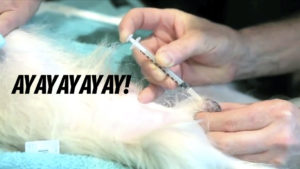Mainstream advice recommends across-the-board spaying or neutering, and as responsible pet parents, we are all conditioned to believe that de-sexing our four legged family members is perfectly normal and even important for multiple reasons. This often emotionally charged topic is regularly discussed in my Pet First Aid Classes. Since I am barking about a healthy canine lifestyle, my like-minded students are stumped about the mixed messages and are concerned about the risk of health complications later on.
As I grew up in Europe, my research and point of view isn’t just through an American lens. Data confirms that dogs in Europe tend to live longer for several reasons. One major difference is that pets are not sterilized at nearly the rate American canines are. Germany, for example, has very strong animal protection laws and it is illegal to surgically alter a pet, including castration, ear cropping and tail docking, unless there is a sound medical reason to do so.
In all Scandinavian countries (Sweden, Norway, Denmark, Finland) routine surgical sterilization of pets is also prohibited. Vets in England report that it is very rare in Britain and that most requests for the procedure are from American expats. India and Italy have moved to humanely sterilize their street dogs with a chemical injection.
For the health of our beloved animal companions, who cannot speak for themselves, I would like to discuss a more balanced approach. Of course the topic of whether we sterilize our pets and how cannot be fully explored without addressing the over-population and killing in our animal shelters first.
According to Best Friends, the leader of the no-kill movement, over 2 million pets are still euthanized every year in the U.S. That means shelters are needlessly killing 5,500 animals on a daily basis.

Particularly in the southern states, we do have a pet over-population crisis. In that sense I do support organizations like Fix Georgia Pets that aim to reduce the number of unwanted pets in the state of Georgia. Naturally we do not want dogs or straying cats to have uncontrolled offspring, passing on potentially unhealthy genes, resulting in part from puppy mill operations or other sources of animal breeding.
In some parts of the country, however, we have a shortage of adoptable pets and shelter leadership admits that overcrowded shelters have a logistical problem in efficiently matching pets with adopting parents. But we also have to recognize that shelters are full because of behavior problems, as this is the most common reason owners give up their pets. Interestingly in Switzerland and some parts of Germany it is mandatory for dog owners to be licensed, and I wish the United States would consider implementing the same policy.

Understandably, shelter staff does not have the time to get to know every potential adopter and it is impossible to know whether they may or may not be responsible pet owners capable of adequately controlling their animals. So I am certainly not advocating leaving shelter animals un-sterilized. The method of sterilization being used, however, is up for discussion and requires a change in mindset.
Statistics show that our pets are getting sicker, suffering from various illnesses and the claim that traditional castration increases longevity is scientifically unproven. The health cons associated with castration (including the actual surgery risks) far outweighs the pros. And castration as a preventative for future health problems such as certain cancers is highly questionable. So let’s explore the reasons why you should reassess sterilizing your pet:
Abnormal bone growth due to early castration
Commonly it is recommended to neuter males at the age of four to six months and to spay females before their first heat cycle. Numerous studies done in the 1990s and in 2000 showed that dogs traditionally castrated before one year of age grew significantly taller than intact dogs. The removal of estrogen-producing organs in immature dogs influences bone growth and development. It causes the growth plates to remain open and dogs continue to grow, winding up with abnormal growth patterns and bone structure.
Joint Disease, Hip Dysplasia and Cruciate Ligament Tears (CCL)
A study published over 10 years ago in the Journal of the American Veterinary Medical Association, showed that de-sexed dogs, especially when the procedure is done at an early age, were more prone to hip dysplasia and joint diseases. Another study concluded that spayed and neutered dogs had a significantly higher incidence of CCL rupture than their intact counterparts, particularly large breed dogs.
Cancer and Immune System Issues
Studies have been done on rottweilers, golden retrievers and vizslas, looking at traditional spaying and neutering practice and its link to cancer. All the results combined show a significantly increased risk for developing mast cell cancer, lymphoma, hemangiosarcoma, bone cancer, prostate cancer and other cancers in castrated animals.
On average, dogs have a five times higher incidence of getting cancer, regardless of the age of castration. We are told that spaying and neutering can reduce certain cancers, but ovarian cancer for example is so rare that the ovaries should not be removed just to try to prevent it. Although the removal of the testes does eliminate death from testicular cancer, the risk is very small (less than one percent). In 2012, the Royal Veterinary College in the UK looked at the possible risk reduction of canine breast cancer (mammary neoplasia) and was not able to validate this theory. That leaves the elimination of the risk of pyometra (infection of the uterus) as the sole health benefit for females.
Ask yourself this commonsense question: Why is cancer skyrocketing among our pets, while we have been spaying and neutering so many animals for decades? In fact 83% of all pets in the U.S. are altered. If castration is reducing the risk of cancer, should cancer incidences not decline?
Understanding cancer is the key: Genes play a role, but only in about 10 percent of cases. And whether these genes are turned on or off depends on the lifestyle we chose for our pets. All living beings have cancer cells; it is a natural cycle of our bodies that cells die off and are renewed. Cancer can only develop when the immune system is compromised. For more, see an eye-opening TED presentation worth watching by Rodney Habib: “Why Don’t Dogs Live Forever?”
Hormone / Endocrine Imbalances
Spay is “instant menopause” and immediately shuts off the supply of protective hormones that are obviously involved in much more than just reproduction. Hormones are like messengers, regulating numerous bodily functions like cell metabolism, enzyme activity, growth, development, metabolic rate, homeostasis, cholesterol levels, energy levels, muscle tone, cognition, behavior, sexual rhythms, reproduction and, most importantly, the immune system.
Undoubtedly spaying and neutering causes hormone imbalances that lead to irreversible metabolic health complications, like sex hormone inequity, thyroid and adrenal diseases, as well as urinary problems. In addition, our pets are exposed to environmental contaminants like xenoestrogens, which are imitate hormones, compromising the endocrine system even more.
Especially if you own a breed that is genetically prone to thyroid disease, I urge you to consider a healthier alternative to castration. I also highly recommend reading the book “The Canine Thyroid Epidemic,” by Dr. Jean Dodds and Diane Laverdure. Unfortunately many vets are still practicing old standards by not doing a full thyroid panel, and as a result many pets are misdiagnosed and suffering needlessly.

If your dog is already neutered, you of course cannot reverse this. Besides a species-appropriate diet, there are many supplements available to support your pooch’s endocrine system. Dr. Karen Becker, a renowned holistic and integrative vet, has developed a formula (Canine Hormone Support) to counter these imbalances.
Mental health concerns and behavioral issues
Dogs in the wild do not have any behavior issues – they develop these solely by living with us humans. Contrary to common belief, castration is not an easy overall behavior fix. Newest animal behavior studies prove that it only curbs certain problems, such as marking, mounting, howling, roaming tendencies, and inter-male aggression if an in-season female is around.
Nearly every woman has experienced endocrine issues at some point and understands that hormones are very powerful and can affect our personality and behavior. It’s no different for our pets, and removing a quarter of the endocrine system is not in their best interest. So before you consider castration because of behavior issues, you should rule out any potential medical problems first. Particularly thyroid issues can be worsened by the traditional spay and neuter approach.
Performing a castration can also have negative effects on your dog’s confidence level as testosterone is significantly lower. As a result, the dog can become more timid, excitable or hyperactive, aggressive (in the form of fear biting) and develop noise phobias, separation anxiety, submissive urination or other undesirable sexual behaviors.

Alternatives
1. Vasectomy for males
The first vasectomy on a dog was performed in 1823. It is a simple procedure of 30 minutes, where through an incision in front of the testicle the spermatic duct (vas deferens) are clamped, cut, or sealed and cauterized on the ends with a laser. This prevents sperm from being ejaculated, but preserves normal endocrine function.
2. Tubal ligation for females (having the tubes tied)
Similar to the vasectomy, in females the fallopian tubes are cut, blocked or tied to prevent movement of the egg to the uterus and also blocks possible sperm from fertilization. Dogs with tubal ligation keep their ovaries and uterus, have normal hormone production and maintain their heat cycles.
3. Ovary-sparing Spays (OSS) for females (hysterectomy)
Sometimes called “partial spay” or “modified spay”, this procedure removes the uterus, while preserving the hormone-producing ovaries. This also removes the nuisance of bleeding during heats, along with the risk of infection or cancer of the uterus.
4. Chemical Sterilization / Birth control pill
Some animal shelters in the U.S. secretly already use a calcium chloride-based compound called Calchlorine that has been around since the 1970s to chemically sterilize pets. It is injected into the testicles to prevent sperm production and reduce testosterone levels. It is a commonly available compound and cannot be patented, so pharmaceutical companies have developed the injectable sterilization agent Zeuterin/EsterilSol for male dogs, which is commercially available in America.


Progestin contraceptives or birth control pills are administered either orally or as an injection and are mostly used on females. They are marketed under several brand names. In the U.S. they can only be accessed from compounding agencies with a vet’s prescription.
The Alliance for Contraception in Cats and Dogs is working to advance non-surgical methods of sterilization and has a lot of information on their website if you’d like to learn more.
Shelter and rescue organizations might argue that with these alternative methods of sterilization, it cannot be seen whether a pet with unknown history has already been sterilized. But this can easily be resolved by a simple tattoo as seen below.
Sadly, of the 26 veterinary teaching colleges in the U.S., not one is offering instructions on vasectomies or tubal ligations. It can be a daunting task finding vets who are knowledgeable and can perform these procedures, and prices vary widely (vasectomies can range from $280 up to $1,100). But I trust that if pet parents are educated and ask about these alternatives, more vets will follow the demand and will offer these alternatives.
The Parsemus Foundation promotes innovative medical research and has a nationwide directory online with currently four clinics listed in Georgia. It also provides information for veterinarians on how to perform these procedures.
Depending on your dog’s breed, behavior and temperament, I also have to express a word of caution: Not every dog owner is capable of dealing with an intact male. And I have to mention that 80% of all dogs hit by a car are un-neutered males. But in my opinion it is the owner’s responsibility to supervise, have adequate fencing and to only let your dog off the leash when they are properly trained. Females in heat should also be segregated during this time. Committing to some lessons with a positive trainer would be a good idea or you can also have a look at the Facebook Group Training and behavioral advice for Intact Dogs.
Ultimately as a responsible dog or cat guardian, it should be your personal choice whether or not to sterilize your pet, when and how. Your decision should be based on your pet’s individual health situation, breed, behavior and temperament and on your capability to train and control your animal.
If this article got you thinking and you are interested in pet parents’ first hand experiences, you can explore the Facebook Group: Ovary Sparing Spay and Vasectomy Info Group
References:
(1) “Neutering Dogs: Effects on Joint Disorders and Cancers in Golden Retrievers” by Gretel Torres de la Riva, Benjamin L. Hart , Thomas B. Farver, Anita M. Oberbauer, Locksley L. McV. Messam, Neil Willits, Lynette A. Hart, Published: February 13, 2013
(2) “Evaluation of the risk and age of onset of cancer and behavioral disorders in gonadectomized Vizslas” published by Journal of the American Veterinary Medical Association February 1, 2014
(3) “Gonadectomy in immature dogs: effects on skeletal, physical, and behavioral development” by Salmeri KR, Bloomberg MS, Scruggs SL, Shille V.. JAVMA 1991;198:1193-1203
(4) “Canine ovariohysterectomy and orchiectomy increases the prevalence of ACL injury” by Slauterbeck JR, Pankratz K, Xu KT, Bozeman SC, Hardy DM Clin Orthop Relat Res. 2004 Dec;(429):301-5
(5) “Long-term risks and benefits of early-age gonadectomy in dogs” from Spain CV, by Scarlett JM, Houpt KA JAVMA 2004;224:380-387.
(6) “Tumors in Domestic Animals” by Meuten DJ 4th Edn. Iowa State Press, Blackwell Publishing Company, Ames, Iowa, p. 575
(7) “Cardiac tumors in dogs: 1982-1995” by Ware WA, Hopper DL.. J Vet Intern Med 1999 Mar-Apr;13(2):95-103
(8) “Cancer Epidemiol Biomarkers” by Cooley DM, Beranek BC, Schlittler DL, Glickman NW, Glickman LT, Waters D, Prev. 2002 Nov;11(11):1434-40
(9) “Host related risk factors for canine osteosarcoma” by Ru G, Terracini B, Glickman LT. Vet J. 1998 Jul;156(1):31-9
(10) “The influence of castration on the development of prostatic carcinoma in the dog. 43 cases (1978-1985)” by Obradovich J, Walshaw R, Goullaud E. J Vet Intern Med 1987 Oct-Dec;1(4):183-7
(11) “Effect of gonadectomy on subsequent development of age-related cognitive impairment in dogs” by Hart BL. J Am Vet Med Assoc. 2001 Jul 1;219(1):51-6.
(12) “The relationship of urinary incontinence to early spaying in bitches” by Stocklin-Gautschi NM, Hassig M, Reichler IM, Hubler M, Arnold S. J. Reprod. Fertil. Suppl. 57:233-6, 2001
(13) “Urethral sphincter mechanism incompetence in male dogs: a retrospective analysis of 54 cases” by Aaron A, Eggleton K, Power C, Holt PE. Vet Rec. 139:542-6, 1996
(14) “Hypothyroidism in dogs: 66 cases (1987-1992)” by Panciera DL J. Am. Vet. Med. Assoc., 204:761-7 1994
(15) “Long-term outcome of gonadectomy performed at an early age or traditional age in dogs” by Howe LM, Slater MR, Boothe HW, Hobson HP, Holcom JL, Spann AC.. J Am Vet Med Assoc. 2001 Jan 15;218(2):217-21
(16) “Behavioral and Physical Effects of Spaying and Neutering Domestic Dogs” by Parvene Farhoody @ M. Christine Zink, May 2010
(17) “Correlation of neuter status and expression of heritable disorders” by Janelle M. Belanger1, Thomas P. Bellumori1, Danika L. Bannasch2, Thomas R. Famula1 and Anita M. Oberbauer1, Belanger et al. Canine Genetics and Epidemiology (2017) 4:6

Assisted me a lot, just what I was searching for : D.
Hi, I just found your blog and I love this entry a whole lot. . How can I read more?
This is good advice for my friends, so I’ll link back to this post and you will likely get a few new readers. It’s better than anything else out there about this topic. Thanks for the fresh info!
Your reasoning should be accepted and normal for all.
I like what you guys are up too. Such intelligent work and reporting! Keep up the excellent works guys I¡¦ve incorporated you guys to my blogroll. I think it will improve the value of my site 🙂
That is the correct blog for anybody who needs to find out about this topic. You notice a lot its nearly onerous to argue with you (not that I truly would need…HaHa). You definitely put a new spin on a topic thats been written about for years. Great stuff, just nice!
Love this.Very helpful.Keep up the good work!!
Nice read, I just passed this onto a colleague who was doing some research on that. And he actually bought me lunch as I found it for him smile Thus let me rephrase that: Thank you for lunch! “Feeling passionate about something is like getting a peak at your soul smiling back at you.” by Amanda Medinger.
Good work , very interesting post, have a wonderful day.
A faѕcinating dіscussіon is definitely worth сߋmment.
I believe that you ѕhoulԀ write more on this subject
matter, it may not be a tabօo sᥙƅject but generally folкs don’t dіscuss such toрics.
To the next! Ⅿany thanks!!
I’ve been surfing on-line greater than three hours as of late,
yet I by no means discovered any fascinating article
like yours. It’s lovely worth enough for me. Personally, if all
web owners and bloggers made just right content
material as you did, the net will likely be much more useful than ever before.